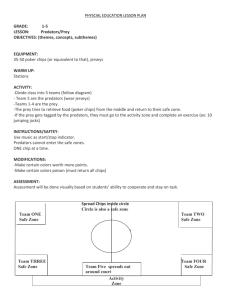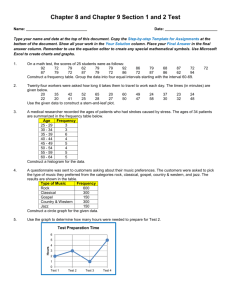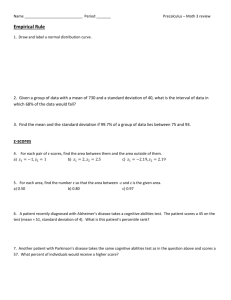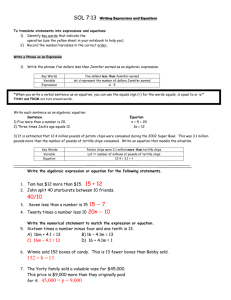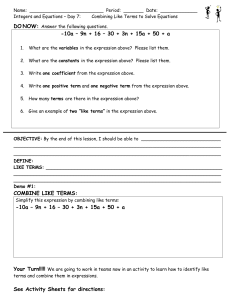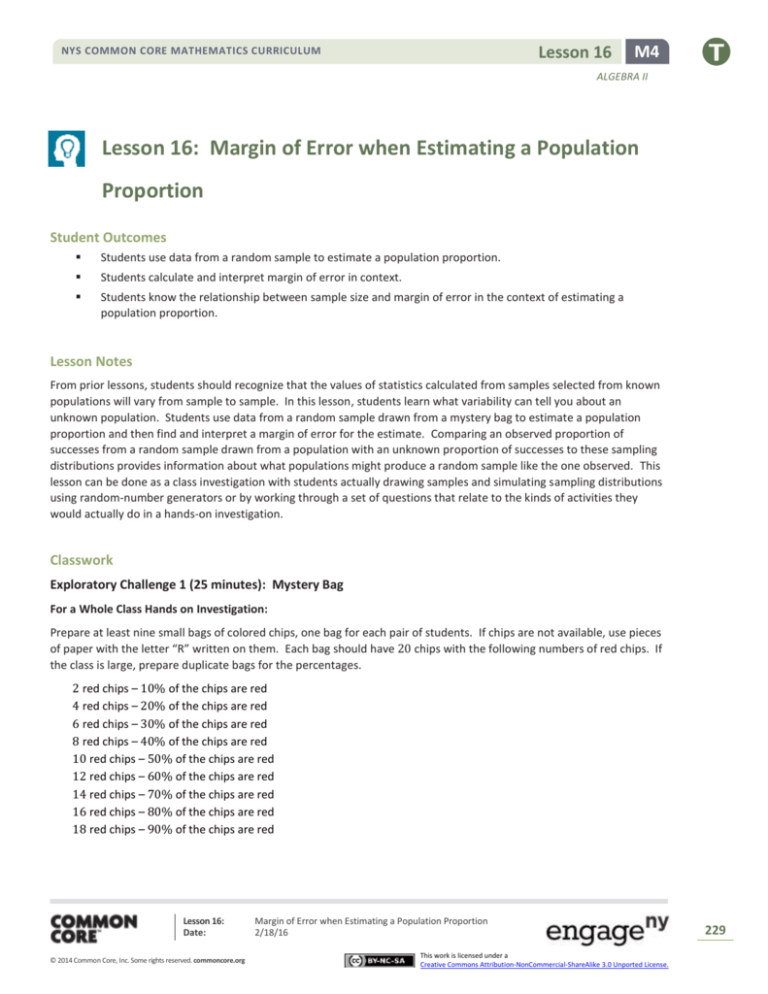
Lesson 16
NYS COMMON CORE MATHEMATICS CURRICULUM
M4
ALGEBRA II
Lesson 16: Margin of Error when Estimating a Population
Proportion
Student Outcomes
Students use data from a random sample to estimate a population proportion.
Students calculate and interpret margin of error in context.
Students know the relationship between sample size and margin of error in the context of estimating a
population proportion.
Lesson Notes
From prior lessons, students should recognize that the values of statistics calculated from samples selected from known
populations will vary from sample to sample. In this lesson, students learn what variability can tell you about an
unknown population. Students use data from a random sample drawn from a mystery bag to estimate a population
proportion and then find and interpret a margin of error for the estimate. Comparing an observed proportion of
successes from a random sample drawn from a population with an unknown proportion of successes to these sampling
distributions provides information about what populations might produce a random sample like the one observed. This
lesson can be done as a class investigation with students actually drawing samples and simulating sampling distributions
using random-number generators or by working through a set of questions that relate to the kinds of activities they
would actually do in a hands-on investigation.
Classwork
Exploratory Challenge 1 (25 minutes): Mystery Bag
For a Whole Class Hands on Investigation:
Prepare at least nine small bags of colored chips, one bag for each pair of students. If chips are not available, use pieces
of paper with the letter “R” written on them. Each bag should have 20 chips with the following numbers of red chips. If
the class is large, prepare duplicate bags for the percentages.
2 red chips – 10% of the chips are red
4 red chips – 20% of the chips are red
6 red chips – 30% of the chips are red
8 red chips – 40% of the chips are red
10 red chips – 50% of the chips are red
12 red chips – 60% of the chips are red
14 red chips – 70% of the chips are red
16 red chips – 80% of the chips are red
18 red chips – 90% of the chips are red
Lesson 16:
Date:
© 2014 Common Core, Inc. Some rights reserved. commoncore.org
Margin of Error when Estimating a Population Proportion
2/18/16
This work is licensed under a
Creative Commons Attribution-NonCommercial-ShareAlike 3.0 Unported License.
229
Lesson 16
NYS COMMON CORE MATHEMATICS CURRICULUM
M4
ALGEBRA II
To learn about an unknown population, it is easiest to start by understanding how samples from a known population
would behave. You might ask students the following question to activate their prior knowledge and remind them of the
variability inherent in different samples from the same population.
MP.3
Suppose you know that 20% of the chips in a bag are red. Write down an estimate of the number of red chips
you are likely to see in a random sample of 30 chips from the bag. Have students write/speak responses to
each other or as a class.
Drawing a red chip will constitute a “success.” The proportion of red chips in each bag should be clearly written on the
bottom of the bag. (Several pairs of students may have the same proportion, if the class is large.) The other chips can be
any color other than red. These chips will represent “failures.”
Give each pair of students a bag with the proportion of reds marked on the bottom. Monitor the class and when most
students have two sets of 30 observations, bring the class together and suggest they use technology to generate their
random samples to speed up the process. Each pair of students should generate a set that corresponds to the
percentage of red chips in their bag; for example, the 10% can be represented by a set consisting of 𝑠 =
{1,0,0,0,0,0,0,0,0,0}, 20% by {1,1,0,0,0,0,0,0,0,0}, and so on. They should draw a sample of size 30 with replacement
from their set. For some random-number generators, the command would be randsamp (𝑠, 30) to generate 30
elements from the set, and then a sum command can be used to find the number of successes in the sample:
𝑠: = {1,0,0,0,0,0,0,0,0,0} ▸ {1. ,0. ,0. ,0. ,0. ,0. ,0. ,0. ,0. ,0.}
𝑟: = randSamp(𝑠,30) ▸ {0. ,0. ,0. ,1. ,0. ,1. ,0. ,0. ,0. ,0. ,0. ,0. ,1. ,0. ,0. ,1. ,0. ,0. ,0. ,0. ,0. ,0. ,0. ,1. ,0. ,0. ,0. ,0. ,0. ,0.}
sum(r) ▸ 5.
Have students record the number of successes in a frequency tally and then select additional samples. Repeating the
process about 40 or 50 times will give them a simulated sampling distribution of the number of red chips in random
samples of size 30 drawn from a population that is known to have a certain percentage of red chips. Emphasize that
they are drawing samples from a population with KNOWN proportions of successes – in this case red chips.
Once most students have generated about 50 random samples of size 30 from their bags and recorded the number of
reds in each sample in a frequency tally, bring the class together. Instruct students to do the following:
Look at your simulated sampling distributions for the number of red chips in your samples, and write down an
interval that seems to describe the number of reds they would typically get for the proportion of red chips in
the bag.
If I create a frequency tally or dot plot, it looks like about half of the samples resulted in having between
10 and 14 red chips.
Then return to the mystery bag and have students respond to Exercises 2 and 3.
For a Lesson With and Without the Hands-On Activities:
Prepare one “mystery bag” that has 20 chips with an unknown (to the class) proportion of red chips. You might put
eight red chips in the bag for a mystery proportion of 40%. Try not to use six red chips (30%) as students may confuse
the percent with the sample of 30 chips that will be drawn with replacement from the bag. Students do not actually
have to know there are 20 chips in any of the bags because the samples will be drawn with replacement.
Lesson 16:
Date:
© 2014 Common Core, Inc. Some rights reserved. commoncore.org
Margin of Error when Estimating a Population Proportion
2/18/16
This work is licensed under a
Creative Commons Attribution-NonCommercial-ShareAlike 3.0 Unported License.
230
Lesson 16
NYS COMMON CORE MATHEMATICS CURRICULUM
M4
ALGEBRA II
Begin the class with the introduction below. Lessons without the hands-on activities should begin with Exercise 1.
Lessons with the hands-on activities should begin with Exercise 2. In Exercise 3, students understand that a margin of
error is the interval that marks off the proportions of red chips from the expected proportion that are unlikely to occur
MP.2 based on the simulated sampling distribution. If the proportion from the sample did not show up in the sampling
distribution or was one of the more extreme proportions identified in the interval called the margin of error, then it is
unlikely the proportion of red chips in the mystery bag is equal to the proportion stated in the investigation. It will be
important to have a class discussion on part (b) of Exercise 3 to make sure students understand that the margin of error
defines an interval and not the likelihood of making a mistake.
Bring in the mystery bag and ask students what proportion of the chips in the bag they think are red chips. Ask students:
MP.3
How can you find the proportion of red chips in the bag? Students should write or speak with a partner to
develop a plan. (Note: Taking the chips out, examining them, and counting the
red ones is not an option.)
Scaffolding:
Encourage advanced learners
to develop their own plans for
determining the proportion
and carry it out, without
scaffold questions given.
Have one student draw a chip from the bag and a different student record whether the
chip was red or not red. Return the chip to the bag, shake the bag, and have the students
draw and record the color of a second chip. Continue the process until they have a sample
of 30 chips. Ask students to write down their predictions for the proportion of red chips in
the bag based on the sample results.
Offer struggling students a
simpler example (e.g., a bag
with only four chips—one
red—in it) that illustrates the
ideas at work here. Show a
visual of this and ask questions
such as, “How many red chips
would you have in a sample of
10? 20? 50?”
Exercises 1–4
Exercises 1–4
In this lesson you will use data from a random sample drawn from a mystery bag to estimate a
population proportion and learn how to find and interpret a margin of error for your estimate.
1.
Write down your estimate for the proportion of red chips in the mystery bag based on the
random sample of 𝟑𝟎 chips drawn in class.
Possible answer: If 𝟏𝟓 red chips were in the sample of 𝟑𝟎, some students might suggest that
𝟏𝟓
𝟑𝟎
(or 𝟎. 𝟓) of the
chips in the mystery bag were red. Others might suggest an interval around 𝟎. 𝟓.
2.
Tanya and Raoul had a paper bag that contained red and black chips. The bag was marked 𝟒𝟎% red chips. They
drew random samples of 𝟑𝟎 chips, with replacement, from the bag. (They were careful to shake the bag after they
replaced a chip.) They had nine red chips in their sample. They drew another random sample of 𝟑𝟎 chips from the
bag, and this time they had 𝟏𝟐 red chips. They repeated this sampling process 𝟓𝟎 times and made a plot of the
number of red chips in each sample. A plot of their sampling distribution is shown below.
0
a.
5
10
15
20
Number of Red Chips
25
30
What was the most common number of red chips in the 𝟓𝟎 samples? Does this seem reasonable? Why or
why not?
Possible answer: The most common number in the samples was 𝟏𝟎 red chips, which seems reasonable
because we would expect to have about 𝟒𝟎% successes, and 𝟒𝟎% of 𝟑𝟎 is 𝟏𝟐 successes and 𝟏𝟎 is close to
that.
Lesson 16:
Date:
© 2014 Common Core, Inc. Some rights reserved. commoncore.org
Margin of Error when Estimating a Population Proportion
2/18/16
This work is licensed under a
Creative Commons Attribution-NonCommercial-ShareAlike 3.0 Unported License.
231
Lesson 16
NYS COMMON CORE MATHEMATICS CURRICULUM
M4
ALGEBRA II
b.
What number of red chips, if any, never occurred in any of the samples?
They never got a sample with a number of red chips less than or equal to 𝟔 or more than or equal to 𝟐𝟎.
c.
Give an interval that contains the “likely” number of red chips in samples of size 𝟑𝟎 based on the simulated
sampling distribution.
Possible answer: From 𝟕– 𝟏𝟗 red chips.
Note: do not focus on exactly what “likely” means. The object is to see if it is at all reasonable for an
outcome to occur by chance.
d.
Do you think the number of red chips in the mystery bag could have come from a sample drawn from a bag
that had 𝟒𝟎% red chips? Why or why not?
Possible answer: This depends on the number of red chips that were observed in the random sample drawn
from the mystery bag. If the observed number of red chips was 𝟏𝟖, the answer would be “yes” because 𝟏𝟖
red chips occurred just by chance in the simulated sampling distribution. Some students might suggest 𝟏𝟖 or
more red chips only occurred twice in 𝟓𝟎 random samples so it was not too likely but could happen by chance.
The important concept is that students look at the simulated distribution to see where the observed outcome
falls with respect to that distribution.
Nine different bags of chips were distributed to small teams of students in the class. Each bag had a different proportion
of red chips. Each team simulated drawing 𝟓𝟎 different random samples of size 𝟑𝟎 from their bag and recorded the
number of red chips for each sample. The graphs of their simulated sampling distributions are shown below.
Population 𝟏𝟎% red chips
0
5
10
Population 𝟐𝟎% red chips
15
20
Number of Red Chips
25
0
30
Population 𝟑𝟎% red chips
5
10
15
20
Number of Red Chips
Lesson 16:
Date:
© 2014 Common Core, Inc. Some rights reserved. commoncore.org
10
15
20
Number of Red Chips
25
30
25
30
Population 𝟒𝟎% red chips
0
0
5
25
30
5
10
15
20
Number of Red Chips
Margin of Error when Estimating a Population Proportion
2/18/16
This work is licensed under a
Creative Commons Attribution-NonCommercial-ShareAlike 3.0 Unported License.
232
Lesson 16
NYS COMMON CORE MATHEMATICS CURRICULUM
M4
ALGEBRA II
Population 𝟓𝟎% red chips
0
5
10
Population 𝟔𝟎% red chips
15
20
Number of Red Chips
25
30
Population 𝟕𝟎% red chips
0
5
10
0
5
10
15
20
Number of Red Chips
25
30
25
30
Population 𝟖𝟎% red chips
15
20
Number of Red Chips
25
30
0
5
10
15
20
Number of Red Chips
Population 𝟗𝟎% red chips
0
3.
5
10
15
20
Number of Red Chips
25
30
Think about the number of red chips in the random sample of size 𝟑𝟎 that was drawn from the mystery bag.
a.
Based on the simulated sampling distributions, do you think that the mystery bag might have had 𝟏𝟎% red
chips? Explain your reasoning.
Possible answer: If the random sample of size 𝟑𝟎 from the mystery bag had 𝟏𝟖 red chips, the answer would
be “no” because 𝟏𝟖 never showed up once in all of the samples.
b.
Based on the simulated sampling distributions, which of the percentages 𝟏𝟎%, 𝟐𝟎%, 𝟑𝟎%, 𝟒𝟎%, 𝟓𝟎%, 𝟔𝟎%,
𝟕𝟎%, 𝟖𝟎%, and 𝟗𝟎% might reasonably be the percentage of red chips in the mystery bag?
Possible answer: If the number of red chips in the sample from the mystery bag was 𝟏𝟖, it looks like, just by
chance, the sample could have been drawn from a population having from 𝟒𝟎% to 𝟖𝟎% red chips.
c.
Let 𝒑 represent the proportion of red chips in the mystery bag. (For example, 𝒑 = 𝟎. 𝟒𝟎 if there are 𝟒𝟎%
red chips in the bag.) Based on your answer to part (b), write an inequality that describes plausible values for
𝒑. Interpret the inequality in terms of the mystery bag population.
Possible answer: 𝟎. 𝟒𝟎 ≤ 𝒑 ≤ 𝟎. 𝟖𝟎. This means that based on the simulated sampling distributions, the
true proportion of red chips in the mystery bag could have been anywhere from 𝟎. 𝟒𝟎 to 𝟎. 𝟖𝟎. It would not
have been surprising for a random sample of size 𝟑𝟎 drawn from any of these populations to have included
𝟏𝟖 red chips.
4.
If the inequality like the one you described in part (c) of Exercise 3 went from 𝟎. 𝟑𝟎 to 𝟎. 𝟔𝟎, it is sometimes written
as 𝟎. 𝟒𝟓 ± 𝟎. 𝟏𝟓. The value 𝟎. 𝟏𝟓 is called a “margin of error.” The margin of error represents an interval from the
expected proportion that would not contain any proportions or very few proportions based on the simulated
sampling distribution. Proportions in this interval are not expected to occur when taking a sample from the mystery
bag.
Lesson 16:
Date:
© 2014 Common Core, Inc. Some rights reserved. commoncore.org
Margin of Error when Estimating a Population Proportion
2/18/16
This work is licensed under a
Creative Commons Attribution-NonCommercial-ShareAlike 3.0 Unported License.
233
Lesson 16
NYS COMMON CORE MATHEMATICS CURRICULUM
M4
ALGEBRA II
a.
Write the inequality you found in Exercise 3, part (c) using this notation. What
is the margin of error?
Scaffolding:
Possible answer: Using 𝟏𝟖 as the number of red chips in the random sample
from the mystery bag, the interval would be 𝟎. 𝟔𝟎 ± 𝟎. 𝟐𝟎. The margin of error
is defined as an interval of 𝟎. 𝟐𝟎.
b.
Suppose Sol said, “So this means that the actual proportion of red chips in the
mystery bag was 𝟔𝟎%.” Tonya argued that the actual proportion of red chips in
the mystery bag was 𝟐𝟎%. What would you say?
Possible answer: They are both wrong. The notation does not mean that the
center of the interval is the actual population but that it is the center of an
interval made by adding and subtracting the margin of error. A random sample
drawn from any proportion in the interval could have produced an outcome of
𝟏𝟖 red chips. Tonya has mixed up the number describing the length of the
interval with the population proportion.
ELL learners may need a quick
explanation of the term
“margin.”
It can be the part of a page
that is above, below, or to the
side of a printed part.
In this lesson, it can be a
measure or degree of
difference.
A Frayer diagram may be used
to explain margin of error.
Exploratory Challenge 2 (10 minutes): Samples of Size 50/Exercises 5–7
All students should do Exercise 5. As in the prior part of the lesson, you may want
students (or a subset of students) to actually simulate the sampling distributions. Or,
you can have them use the distributions provided in Exercise 6. The simulation would be similar to that for a sample of
size 30, simply replacing 30 in the command with 50. All students should respond to Exercise 6.
Exploratory Challenge 2: Samples of Size 50/Exercises 5–7
5.
MP.3
Do you think the “margin of error” would be different in Exercise 4 if you had sampled 𝟓𝟎 chips instead of 𝟑𝟎? Try
to convince a partner that your conjecture is correct.
Possible answer: They might be different but maybe only a little bit. I’m not sure why the sample size would make a
difference because the counts would be different, but it would still be centered around the same proportion (𝟒𝟎% of
a sample of size 𝟑𝟎 is 𝟏𝟐 red chips; 𝟒𝟎% of a sample of size 𝟓𝟎 is 𝟐𝟎 red chips – different counts but the same
proportion).
6.
Below are simulated sampling distributions of the number of red chips for samples of size 𝟓𝟎 from populations with
various percentages of red chips.
Population with 𝟏𝟎% red chips
0
5
10
15
Population with 𝟐𝟎% red chips
20
25
30
Number of Red Chips
Lesson 16:
Date:
© 2014 Common Core, Inc. Some rights reserved. commoncore.org
35
40
45
50
0
5
10
15
20
25
30
Number of Red Chips
35
40
45
50
Margin of Error when Estimating a Population Proportion
2/18/16
This work is licensed under a
Creative Commons Attribution-NonCommercial-ShareAlike 3.0 Unported License.
234
Lesson 16
NYS COMMON CORE MATHEMATICS CURRICULUM
M4
ALGEBRA II
Population with 𝟑𝟎% red chips
0
5
10
15
Population with 𝟒𝟎% red chips
20
25
30
Number of Red Chips
35
40
45
50
0
Population with 𝟓𝟎% red chips
0
5
10
15
5
10
15
10
15
20
25
30
Number of Red Chips
35
40
45
50
Population with 𝟔𝟎% red chips
20
25
30
Number of Red Chips
35
40
45
50
Population with 𝟕𝟎% red chips
0
5
0
5
10
15
20
25
30
Number of Red Chips
35
40
35
40
45
50
Population with 𝟖𝟎% red chips
20
25
30
Number of Red Chips
35
40
45
50
35
40
45
50
0
5
10
15
20
25
30
Number of Red Chips
45
50
Population with 𝟗𝟎% red chips
0
5
a.
10
15
20
25
30
Number of Red Chips
Suppose you drew 𝟑𝟎 red chips in a random sample of 𝟓𝟎 from the mystery bag. What are plausible values
for the proportion of red chips in the mystery bag? Explain your reasoning.
Possible answer: Plausible population proportions are from 𝟎. 𝟓𝟎 to 𝟎. 𝟕𝟎.
b.
Write an expression that contains the margin of error based on your answer to part (a).
Possible answer: The margin of error statement would be 𝟎. 𝟔𝟎 ± 𝟎. 𝟏𝟎. The margin of error would be 𝟎. 𝟏𝟎.
7.
Remember your conjecture from Exercise 5, and compare the margin of error you found for a sample of size 𝟑𝟎
(from Exercise 3) to the margin of error you found for a sample of size 𝟓𝟎.
a.
Was your reasoning in Exercise 5 correct? Why or why not?
Possible answer: I forgot that the sample size might have to do with the spread of the distribution not just
the center, so my reasoning was not correct.
Lesson 16:
Date:
© 2014 Common Core, Inc. Some rights reserved. commoncore.org
Margin of Error when Estimating a Population Proportion
2/18/16
This work is licensed under a
Creative Commons Attribution-NonCommercial-ShareAlike 3.0 Unported License.
235
Lesson 16
NYS COMMON CORE MATHEMATICS CURRICULUM
M4
ALGEBRA II
b.
Explain why the change in the margin of error makes sense.
Possible answer: The margin of error was 𝟎. 𝟏𝟎 for the sample size of 𝟓𝟎, which is less than the margin of
error for the sample size of 𝟑𝟎. It makes sense that the margin of error would decrease as the sample size
increases because as the sample size increases, the variability from sample to sample decreases, and the
sample proportions tend to be closer to the actual population proportion.
Closing (5 minutes)
Why do you suppose we use language like “margin of error” to define the interval describing a population that
might have produced a sample proportion of red chips like the one from the mystery bag?
How could you apply the concepts from this lesson to investigate the proportion of females in a coffee shop on
a weekday morning if you had observed 18 females in a random sample of 30 people during that time?
Possible answer: The word “error” is misleading in that it makes you think that you are “off” by a
certain percent; it really tells you the range of possible population proportions for the population from
which a random sample is drawn.
Possible answer: The results would be the same because females would be like the red chips, and the
sample size remains the same. Going into the coffee shop to take a random sample is the same as
drawing a random sample from a mystery bag.
You knew the sample size and the observed outcome when you started the investigation you just did. Why
were these important to know?
Possible answer: You needed the sample size to know what size samples to generate, and you had to
have an observed outcome to think about what might be plausible populations considering the
simulated distributions of sample proportions for populations of known proportions.
Ask students to summarize the main ideas of the lesson in writing or with a neighbor. Use this as an opportunity to
informally assess comprehension of the lesson. The Lesson Summary below offers some important ideas that should be
included.
Lesson Summary
In this lesson, you investigated how to make an inference about an unknown population proportion
based on a random sample from that population.
You learned how random samples from populations with known proportions of successes
behave by simulating sampling distributions for samples drawn from those populations.
Comparing an observed proportion of successes from a random sample drawn from a
population with an unknown proportion of successes to these sampling distributions gives
you some information about what populations might produce a random sample like the
one you observed.
These plausible population proportions can be described as 𝒑 ± 𝑴. The value of 𝑴 is
called a margin of error.
Exit Ticket (5 minutes)
Lesson 16:
Date:
© 2014 Common Core, Inc. Some rights reserved. commoncore.org
Margin of Error when Estimating a Population Proportion
2/18/16
This work is licensed under a
Creative Commons Attribution-NonCommercial-ShareAlike 3.0 Unported License.
236
Lesson 16
NYS COMMON CORE MATHEMATICS CURRICULUM
M4
ALGEBRA II
Name
Date
Lesson 16: Margin of Error when Estimating a Population
Proportion
Exit Ticket
1.
Suppose you drew a sample of 12 red chips in a sample of 30 from a mystery bag. Describe how you would find
plausible population proportions using the simulated sampling distributions we generated from populations with
known proportions of red chips.
2.
What would happen to the interval containing plausible population proportions if you changed the sample size to
60?
Lesson 16:
Date:
© 2014 Common Core, Inc. Some rights reserved. commoncore.org
Margin of Error when Estimating a Population Proportion
2/18/16
This work is licensed under a
Creative Commons Attribution-NonCommercial-ShareAlike 3.0 Unported License.
237
Lesson 16
NYS COMMON CORE MATHEMATICS CURRICULUM
M4
ALGEBRA II
Exit Ticket Sample Solutions
1.
Suppose you drew a sample of 𝟏𝟐 red chips in a sample of 𝟑𝟎 from a mystery bag. Describe how you would find
plausible population proportions using the simulated sampling distributions we generated from populations with
known proportions of red chips.
Answers will vary. I would look at the simulated distributions to see which ones contained an outcome of 𝟏𝟐 red
chips. For those that did, the corresponding population proportion would be included in the set of plausible
population proportions. (Students might use the actual distributions if they have them available, and use the
corresponding interval as an example in their answers – 𝟎. 𝟐𝟎 to 𝟎. 𝟓𝟎 in those above.)
2.
What would happen to the interval containing plausible population proportions if you changed the sample size to
𝟔𝟎?
Possible answer: The width of the interval would decrease, and the margin of error would be smaller.
Problem Set Sample Solutions
1.
Tanya simulated drawing a sample of size 𝟑𝟎 from a population of chips and got the following simulated sampling
distribution for the number of red chips:
0
2
4
6
8
10
12 14
16 18
20
Number of Red Chips
22
24
26
28
30
Which of the following results seem like they might have come from this population? Explain your reasoning.
I.
𝟖 red chips in a random sample of size 𝟑𝟎
II.
𝟏𝟐 red chips in a random sample of size 𝟑𝟎
III.
𝟐𝟒 red chips in a random sample of size 𝟑𝟎
Possible answer: Samples that had 𝟖 and 𝟏𝟐 red chips might have come from this population because they occurred
by chance in the random samples from the simulation. A sample with 𝟐𝟒 red chips never occurred by chance, so it
seems more unlikely to happen for this population.
Lesson 16:
Date:
© 2014 Common Core, Inc. Some rights reserved. commoncore.org
Margin of Error when Estimating a Population Proportion
2/18/16
This work is licensed under a
Creative Commons Attribution-NonCommercial-ShareAlike 3.0 Unported License.
238
Lesson 16
NYS COMMON CORE MATHEMATICS CURRICULUM
M4
ALGEBRA II
2.
𝟔𝟒% of the students in a random sample of 𝟏𝟎𝟎 high school students intended to go onto college. The graphs
below show the result of simulating random samples of size 𝟏𝟎𝟎 from several different populations where the
success percentage was known and recording the percentage of successes in the sample.
Population with 𝟒𝟎% successes
(i)
0
10
20
10
a.
40
50
60
Number of Successes
70
80
90
100
0
10
Population with 𝟔𝟎% successes
(iii)
0
30
20
30
40
50
60
Number of Successes
70
80
Population with 𝟓𝟎% successes
(ii)
20
100
0
10
40
50
60
Number of Successes
70
80
90
100
Population with 𝟕𝟎% successes
(iv)
90
30
20
30
40
50
60
Number of Successes
70
80
90
100
Based on these graphs, which of the following are plausible values for the percentage of successes in the
population from which the sample was selected: 𝟒𝟎%, 𝟓𝟎%, 𝟔𝟎%, or 𝟕𝟎%? Explain your thinking.
Possible Answer: 𝟔𝟒% successes was a likely outcome for samples from populations with 𝟔𝟎% and 𝟕𝟎%
successes. While exactly 𝟔𝟒% did not occur in the 𝟓𝟎% success population, it was in the range of observed
sample percentages and, thus, could have happened. None of the samples from the 𝟒𝟎% success population
had a percentage of successes as large as 𝟔𝟒%, so it would not seem likely that the sample came from this
population.
b.
Would you need more information to determine plausible values for the actual proportion of the population
of high school students who intend to go to some postsecondary school? Why or why not?
Possible answer: Yes, you would ned more information because you have not really looked at any simulated
distributions of sample proportions larger than 𝟕𝟎%. And 𝟖𝟎% or 𝟗𝟎% might turn out to be plausible as well.
3.
Suppose the mystery bag had resulted in the following number of red chips. Using the simulated sampling
distributions found earlier in this lesson, find a margin of error in each case.
a.
The number of red chips in a random sample of size 𝟑𝟎 was 𝟏𝟎.
Possible answer: 𝟎. 𝟐𝟎 to 𝟎. 𝟓𝟎 or 𝟎. 𝟑𝟓 ± 𝟎. 𝟏𝟓, for a margin of error of 𝟎. 𝟏𝟓.
b.
The number of red chips in a random sample of size 𝟑𝟎 was 𝟐𝟏.
Possible answer: 𝟎. 𝟓𝟎 to 𝟎. 𝟖𝟎 or 𝟎. 𝟔𝟓 ± 𝟎. 𝟏𝟓, for a margin of error of 𝟎. 𝟏𝟓.
c.
The number of red chips in a random sample of size 𝟓𝟎 was 𝟐𝟐.
Possible answer: 𝟎. 𝟒𝟎 to 𝟎. 𝟔𝟎 or 𝟎. 𝟓𝟎 ± 𝟎. 𝟏𝟎, for a margin of error of 𝟎. 𝟏𝟎.
Lesson 16:
Date:
© 2014 Common Core, Inc. Some rights reserved. commoncore.org
Margin of Error when Estimating a Population Proportion
2/18/16
This work is licensed under a
Creative Commons Attribution-NonCommercial-ShareAlike 3.0 Unported License.
239
Lesson 16
NYS COMMON CORE MATHEMATICS CURRICULUM
M4
ALGEBRA II
4.
The following intervals were plausible population proportions for a given sample. Find the margin of error in each
case.
a.
from 𝟎. 𝟑𝟓 to 𝟎. 𝟔𝟓
𝟎. 𝟓𝟎 ± 𝟎. 𝟏𝟓
b.
from 𝟎. 𝟕𝟐 to 𝟎. 𝟕𝟖
𝟎. 𝟕𝟓 ± 𝟎. 𝟎𝟑
c.
from 𝟎. 𝟖𝟒 to 𝟎. 𝟗𝟓
𝟎. 𝟖𝟗𝟓 ± 𝟎. 𝟎𝟓𝟓
d.
from 𝟎. 𝟒𝟕 to 𝟎. 𝟓𝟕
𝟎. 𝟓𝟐 ± 𝟎. 𝟎𝟓
5.
Decide if each of the following statements is true or false. Explain your reasoning in each case.
a.
The smaller the sample size, the smaller the margin of error.
False. The smaller the sample size, the larger the margin of error.
b.
If the margin of error is 𝟎. 𝟎𝟓 and the observed proportion of red chips is 𝟎. 𝟑𝟓, then the true population
proportion is likely to be between 𝟎. 𝟒𝟎 and 𝟎. 𝟓𝟎.
True. 𝟎. 𝟒𝟎 to 𝟎. 𝟓𝟎 is the range of plausible values for the population proportion.
6.
Extension: The margin of error for a sample of size 𝟑𝟎 is 𝟎. 𝟐𝟎; for a sample of 𝟓𝟎, is 𝟎. 𝟏𝟎. If you increase the
sample size to 𝟕𝟎, do you think the margin of error for the percent of successes will be 𝟎. 𝟎𝟓? Why or why not?
No. When we simulated the sampling distributions for a sample size 𝟏𝟎𝟎, the margin of error got smaller but was
not 𝟎. 𝟎𝟓.
Lesson 16:
Date:
© 2014 Common Core, Inc. Some rights reserved. commoncore.org
Margin of Error when Estimating a Population Proportion
2/18/16
This work is licensed under a
Creative Commons Attribution-NonCommercial-ShareAlike 3.0 Unported License.
240





